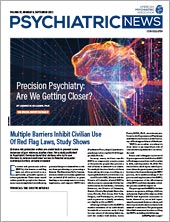Last year, the Albert Lasker Basic Medical Research Award was given to the researchers who discovered light-sensitive microbial proteins known as opsins and developed a technique known as optogenetics that uses these proteins to manipulate neurons. This award, considered one of the most prestigious in medicine and a common gateway to a future Nobel prize, shows how far optogenetics has come in 15 years—from an unconventional neuroscience tool in studies of animals to one being considered as a neuromodulation therapy for people.
Unlike existing neuromodulation treatments such as electroconvulsive therapy (ECT) and transcranial magnetic stimulation (TMS), “optogenetics is a form of gene therapy that requires you to deliver specially modified genes to the target neurons,” explained Ed Boyden, Ph.D., the Y. Eva Tan Professor in Neurotechnology at the Massachusetts Institute of Technology. (Boyden collaborated with Lasker Prize winner Karl Deisseroth, M.D., Ph.D., a professor of psychiatry at Stanford University, to pioneer this technique.) These modified genes include microbial opsin DNA and thus produce proteins that respond to optical energy at specific wavelengths. When exposed to the right wavelength of light, the opsin proteins trigger an electrical signal that either stimulates or inhibits the activity of the neurons. Most opsins react to specific colors on the visible light spectrum, so optogenetics does not expose brain tissue to more damaging energy such as ultraviolet or X-ray light.
The desired genes are packed into vectors that contain bits of viral DNA; when injected into a part of the body, these vectors will enter a cell and splice the selected gene into the host chromosomes, just as many viruses do.
While the need for a genetic intermediary adds a layer of complexity to optogenetic stimulation relative to ECT and TMS, optogenetic stimulation provides one critical benefit: specificity.
“We can engineer the vectors we use for gene insertion to be highly selective,” said Meaghan Creed, Ph.D., an associate professor of anesthesiology at Washington University, who is exploring the potential of optogenetics in the management of pain and addiction. Researchers can make as few or as many neurons optically sensitive as they want, which enables precise control of neural activity. Clinically speaking, this precision means optogenetic stimulation could produce fewer side effects compared with ECT or TMS, which target a whole area of the brain, sometimes leading to unintended effects.
Early Trials Show Promise
Though optogenetic tools are still relatively new, they are already showing some therapeutic potential. In 2020, a company called Nanoscope Therapeutics successfully completed a phase 1 clinical trial demonstrating that injecting opsin-containing receptors into the back of an eye could restore vision in people with retinitis pigmentosa—a group of inherited disorders in which a person’s natural retinal photoreceptors degrade over time. The company is currently conducting a phase 2 randomized trial to confirm those preliminary findings.
Preclinical studies have demonstrated that optogenetic stimulation can improve dysfunctional brain activity. For example, researchers at Yale University developed mouse models with opsin-modified dopamine neurons in the prefrontal cortex. When these neurons were stimulated with light, depressive-like behaviors in the mice decreased rapidly, mimicking the effects of ketamine. The researchers published the findings in Nature Communications in 2019.
In work published in Science in 2017, Creed’s lab also found that when opsin-modified neurons in the nucleus accumbens of mice were stimulated, behaviors induced by cocaine exposure—including drug seeking, hyperactivity, and withdrawal—also decreased.
Obstacles Remain
Experts agree that stimulating the brains of people with psychiatric illness using optogenetics will be challenging, as the brain is not as accessible as the eyes—making both the delivery of the vectors and the activation of them with light more difficult. Yet Boyden, Creed, and others who work with these tools think the technical hurdles can be overcome.
“If you look at how far the engineering has advanced over the past several years, it’s definitely possible that optogenetic devices could be clinically feasible,” Creed said.
Early optogenetic research in mice required inserting fiber optic cables into the brains of mice near the neurons of interest. In addition to the required surgery, these setups tethered the mice to bulky batteries, thus preventing natural movements. Today, however, researchers can implant wireless LED electrodes remotely powered by small antennas that can be worn like little backpacks. Just last year, a team at the University of Arizona developed an optogenetic implant for use in mice that was capable of stimulating neurons through the skull using high-intensity red light. (Human skulls are about 20 times thicker than mouse skulls, but studies have shown that infrared light can reach the outer areas of the human brain, and opsins that react to infrared light have been engineered.)
The real obstacle, Boyden said, is that scientists are still very much in the dark when it comes to the neurobiology of psychiatric illnesses.
“Nanoscope’s [retinitis pigmentosa] therapy [which uses an opsin molecule developed by Boyden’s lab] is promising because we have a clear understanding of the problem that needs fixing and the wiring of the human eye,” he said. “We do not have comparable maps of the brain.” If people were to try clinical optogenetic applications in psychiatry now, “it would be like typing out code on a computer without the aid of a monitor.”
Optogenetic Tools Inform Other Therapies
The Herculean task of mapping out the human brain will not be finished anytime soon, but Boyden said he still believes optogenetic manipulations can contribute to medical advances today.
Boyden cited the work he did alongside MIT colleague Li-Huei Tsai, Ph.D., the director of the Picower Institute for Learning and Memory, as one example of how optogenetics may inform medicine. About 10 years ago, Tsai’s team found that optogenetic stimulation of interneurons (the cells that form the node connecting two classes of neurons, such as sensory and motor neurons) could reduce the buildup of amyloid plaques and improve cognition in mice predisposed to develop Alzheimer’s disease. They were able to recreate this effect without optogenetics by exposing mice to soundwaves and flickering lights, each set to 40 Hz (40 waves per second). The sound and light exposure stimulated the interneurons via optical and auditory nerves.
The success of this approach—known as GENUS—in mice paved the way for a recently launched clinical trial of older adults. Tsai’s team is enrolling 50 volunteers who are cognitively normal but show signs of amyloid buildup in brain scans. The participants will receive an hour of GENUS light and sound stimulation or placebo light and sound in their homes daily for a year. The researchers will compare the effects of GENUS on amyloid buildup, as well as changes in cognition, sleep, and more.
Creed is also using optogenetics to inform other therapies, specifically deep brain stimulation (DBS). DBS aims to stimulate specific areas of the brain via implanted electrodes that release electricity. DBS has led to improvements with patients with epilepsy and other neurological disorders and is being considered as a possible treatment for chronic and severe psychiatric disorders, including addiction. One limitation of DBS is that once the electrodes are turned off, the symptoms typically reemerge, Creed noted. In the case of addiction, “a person may temporarily stop taking drugs, but the brain is permanently rewired,” she said.
Studies by Creed’s team using optogenetics in mice displaying addictive-like behaviors revealed that lower frequency stimulation of the reward centers in the brain can alter the location and strength of neuronal connections in these centers, thus potentially undoing some of the drug-induced rewiring. She is currently testing the efficacy of low-frequency DBS on maladaptive symptoms of chronic pain and prescription opioid dependence in mice.
Whether low-frequency DBS, GENUS, or even direct optogenetic therapies for the brain will reach clinical fruition remains to be seen. The optogenetics story “exemplifies the power of taking a molecular approach to explore complex biological systems—even for the disorders that define psychiatry,” said Deisseroth, when accepting the Lasker award. “The hope brought to psychiatry by detailed studies of microbial membrane proteins is an uplifting story for all to share.” ■

